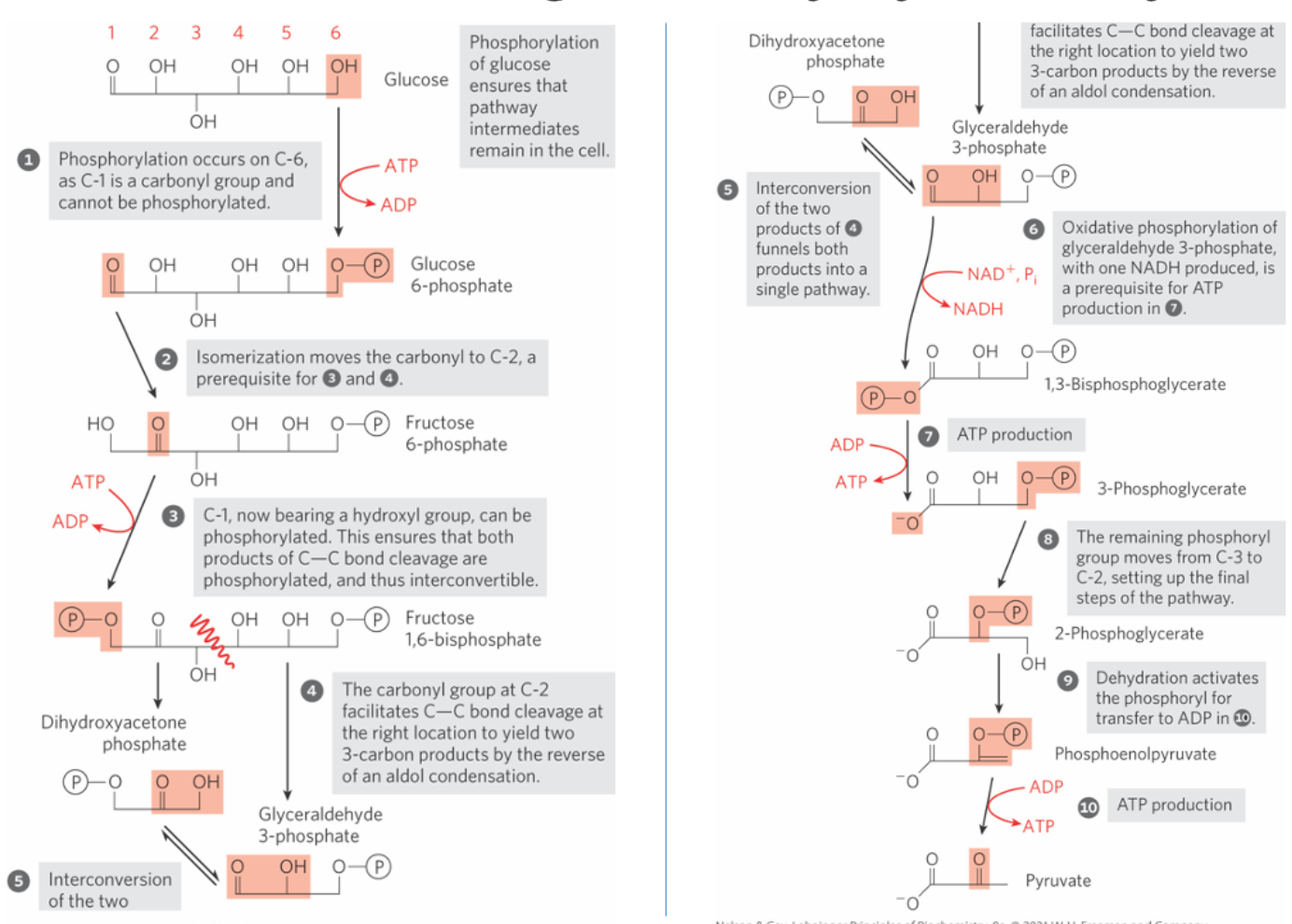02: Carbohydrate Metabolism: Glycolysis and Gluconeogenesis
Glycolysis
Carbohydrate digestion
begins in the mouth
salivary amylase cleaves α- (1,4)-glycosidic bonds of ingested carbohydrates
Salivary amylase is inactivated by the stomach acid
Pancreatic secretions neutralize stomach acid
Oligosaccharides to smaller saccharides; disaccharides further broken down to monosaccharides
Glucose is stored in the liver as glycogen or released in the bloodstream
sugars is taken up in portal circulation
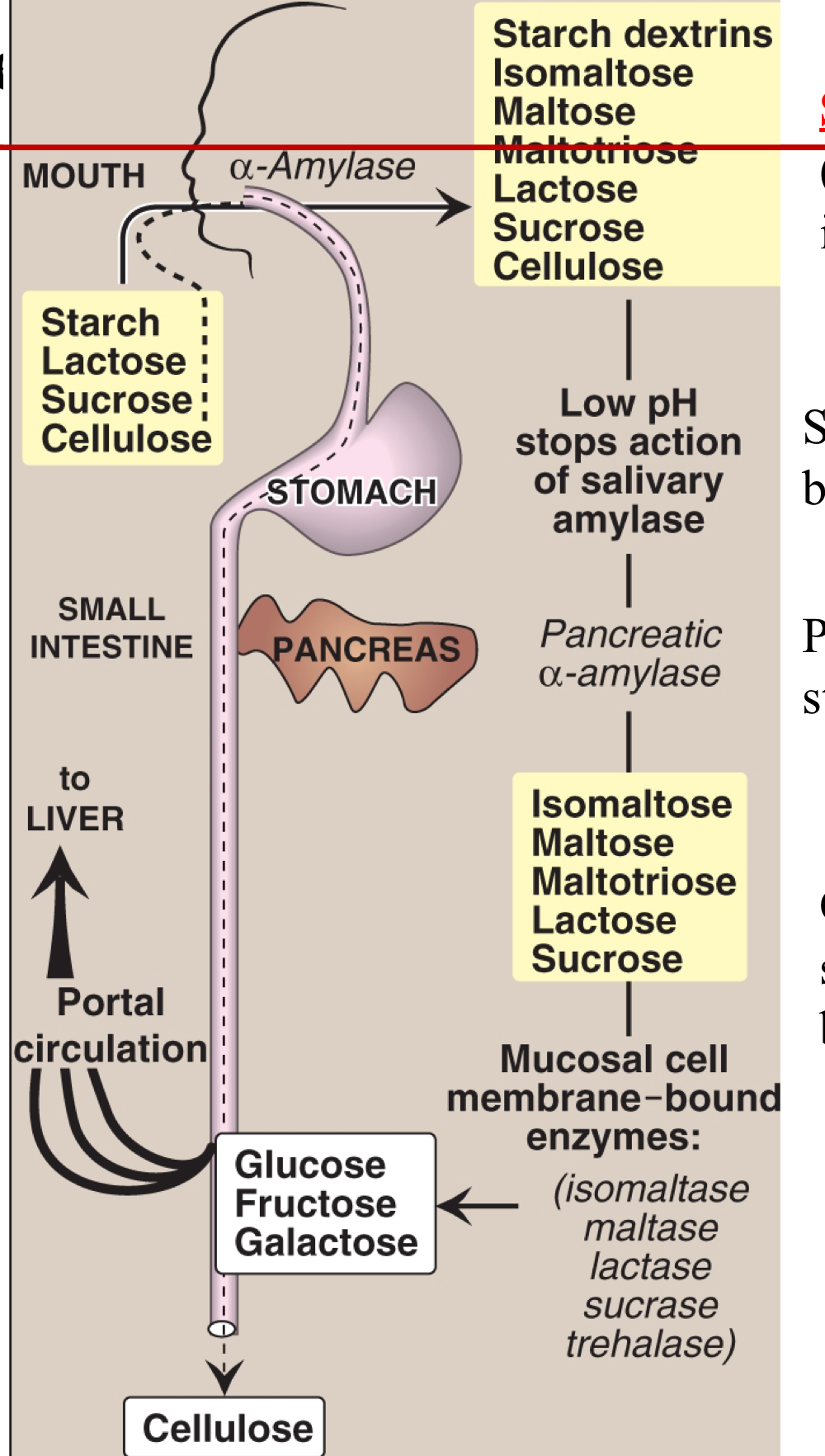
pancreatic a-amylase neutralizes and breaks down sugar
Glucose
is polar because of OH groups —> promotes water solubility
Hexose, monosaccharide
The major form of carbohydrate presented to cells after absorption from
food
Glucose is what fuels the brain, and many other tissues
Brain weighs about 2% of body weight, but receives 20% of total body oxygen consumption, and 25% of total body glucose utilization
Glucose is ‘burned’ to release energy
Biochemical pathways
Uptake in cells is through transporter mechanisms
GLUT transporters
Glucose Transport
Glucose cannot diffuse directly into the cells
Na+ -independent facilitated diffusion
Glucose moves from region of high conc. to low conc.
Mediated by a family of Glucose Transporters (GLUT)
Na+ -dependent co-transporter system
Transport of glucose from low glucose conc. (outside cell) to higher
glucose conc
Process uses energy
Glucose transport follows the Na+ gradient into the cell
Sodium-dependent GLUTs aka SGLT
GLUTs can transport glucose in two ways:
Extracellular to intracellular
Easier along the gradient
Intracellular to extracellular
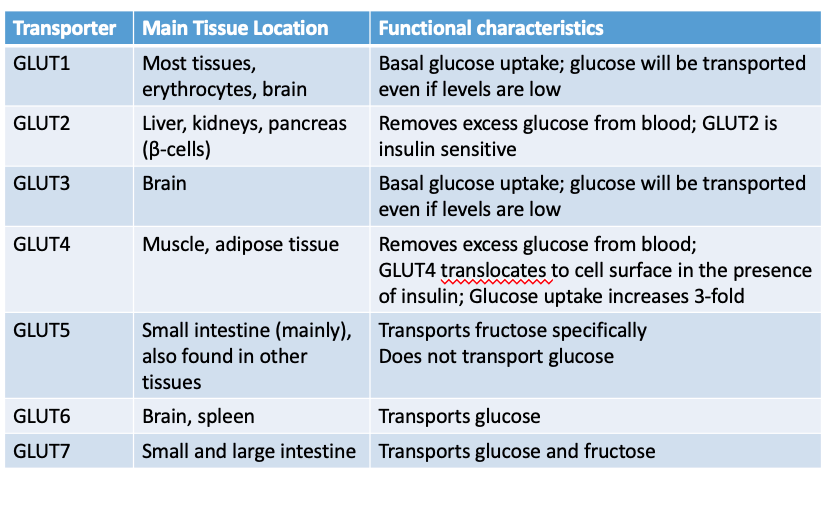
GLUT 1, 3, 6 transports glucose to the brain to ensure that brains always receives a supply of glucose
GLUT 5 transports fructose only (no glucose)
Glucose Transporters (GLUTs)
Two conformational states
Extra-cellular glucose molecule binds to the GLUT (conformational state 1)
The transporter undergoes a change in its conformation (conformational state 2)
The glucose molecule is transported across the cell membrane
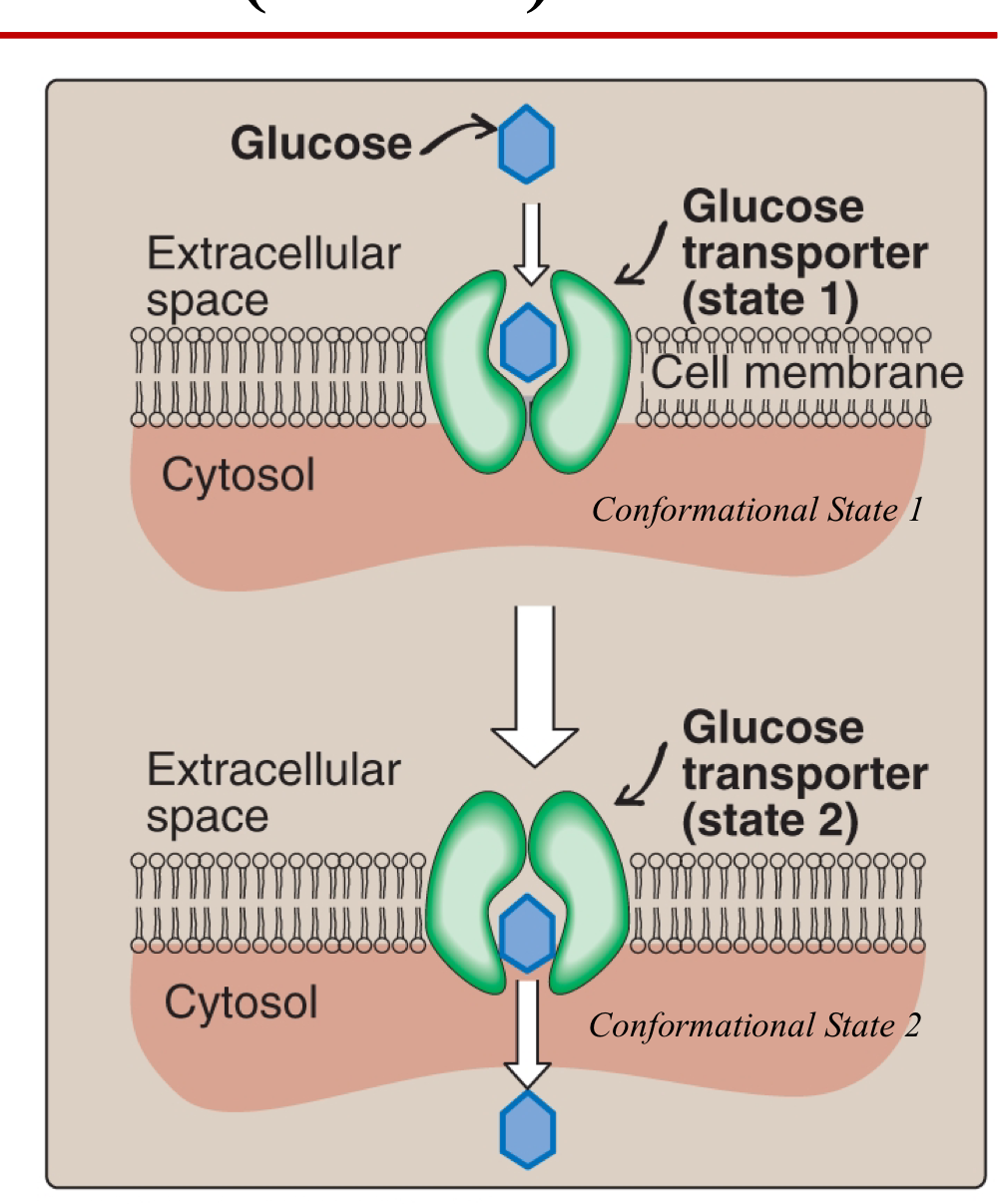
Glycolysis
Primary pathway for the metabolism of glucose
Glycolysis = breakdown (lysis) of glucose
Sometimes, other carbohydrates are modified to glucose
Location: all the cells of the body, in the cytosol
Chemically, what is glycolysis?
It is a pathway
Series of chemical reactions where:
One molecule of glucose (precursor; 6 carbon atoms) is broken down (through many steps) to finally yield two molecules of pyruvic acid (final product, 3 carbon atoms)
Pyruvic acid aka pyruvate
This results in the release of energy in the form of ATP
Catabolic process (anabolic, catabolic)
Aerobic Glycolysis
Presence of oxygen
Important to oxidize NADH+ formed in glycolysis
Step 6: oxidation of glyceraldehyde-3-phosphate
Pyruvate converted to Acetyl CoA in the preparatory step to the Krebs cycle
(TCA cycle, Citric Acid cycle)
Anaerobic glycolysis
Absence of oxygen
Pyruvate is converted to lactate
Allows the production of energy in cells lacking mitochondria (erythrocytes) and cells deprived of oxygen
Cori cycle
Aka fermentation
Overview of Glycolysis
Glycolytic pathway is employed by all tissues
Series of 10 reactions
Breakdown of glucose to provide energy (as ATP)
Also provides intermediates for other metabolic pathways
Glycolysis is the hub of carbohydrate metabolism
All sugars (dietary, metabolic reactions and byproducts) can be converted to glucose
Investment phase of Glycolysis
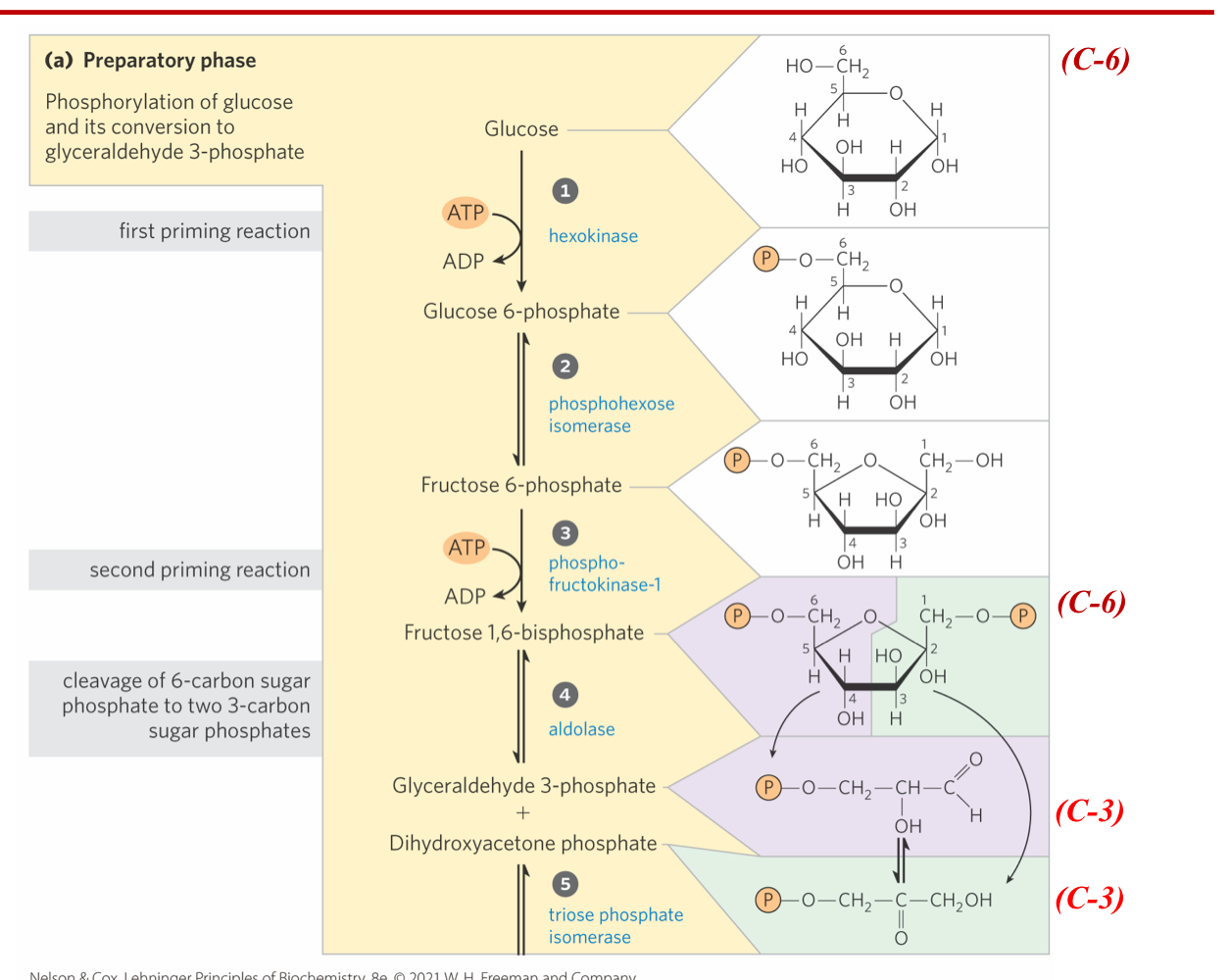
Payoff Phase of Glycolysis
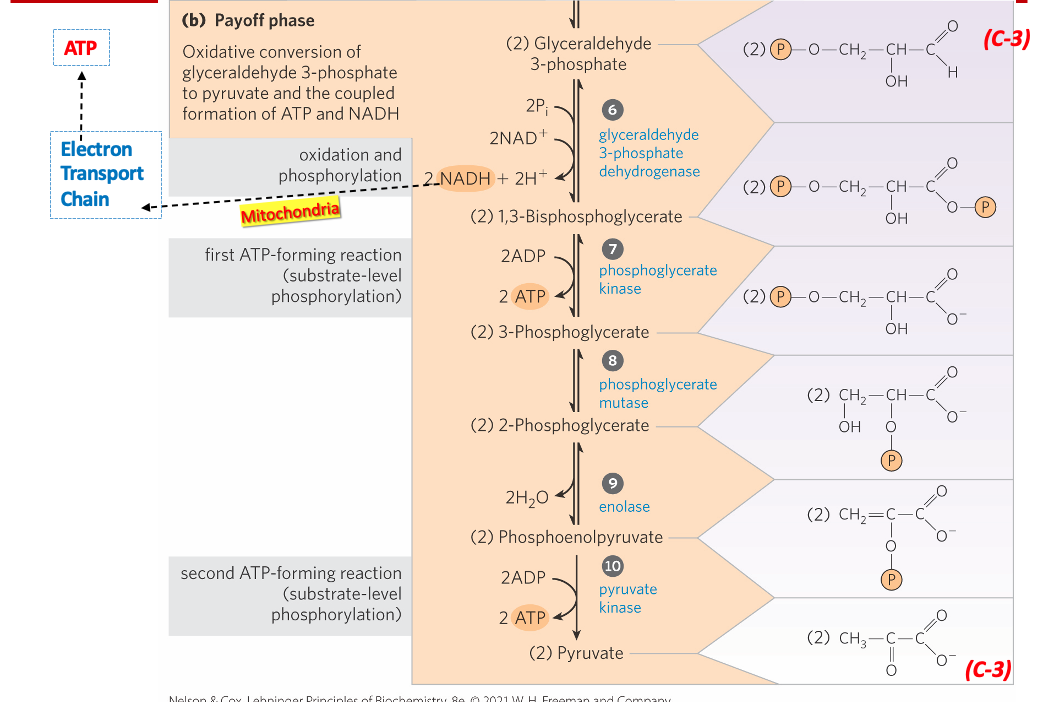
the payoff phase yields:
energy conserved as 2 ATP and 2 NADH
2 pyruvate
Transition from Investment Phase to Payoff phase
Fructose 1,6-bisphosphate is broken down into
Glyceraldehyde 3-phosphate and
Dihydroxyacetone phosphate
50%-50%
Both are C-3 compounds
Aldotriose and Ketotriose – these are interconvertible
Triose phosphate isomerase
Glyceraldehyde 3-phosphate remains intact
DHAP is converted to Glyceraldehyde 3-phosphate
Now you have 100% Glyceraldehyde 3-phosphate
Taken into the payoff phase
Noteworthy Chemical Transformations of Glycolysis
Three noteworthy chemical transformations:
1) degradation of the carbon skeleton of glucose to yield pyruvate
2) phosphorylation of ADP to ATP by compounds with high phosphoryl group transfer potential, formed during glycolysis
3) transfer of a hydride ion to NAD+, forming NADH
The Chemical Logic of Glycolytic Pathway
Glycolysis: Step 1
D-glucose (starting molecule)
Hexokinase (enzyme)
Glucose 6-phosphate (product)
Phosphorylation (reaction type)
Phosphate group is transferred from one ATP molecule to the C6-oxygen atom
Irreversible reaction
First step of a pathway = committed step
“Investment” of ATP
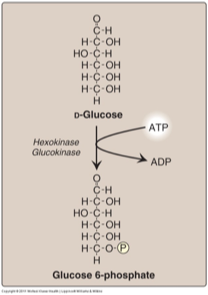
Regulated step
Regulatory enzyme
Irreversible reaction
Glycolysis: Step 2
Glucose 6-phosphate (from step 1)
Phosphoglucose isomerase (enzyme)
Fructose 6-phosphate (product)
Isomerization (reaction type)
Glucose 6-phosphate and Fructose 6-phosphate are isomers
Reversible reaction
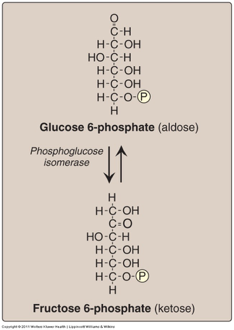
reversible reaction
Glycolysis Step 3
Fructose 6-phosphate (from step 2)
Phosphofructokinase-1 (PFK-1) (enzyme)
Fructose 1,6-bisphosphate (product)
Phosphorylation (reaction type)
Irreversible reaction
Step sets up “splitting the molecule” from one C6 piece to two C3 pieces
“Investment” of ATP
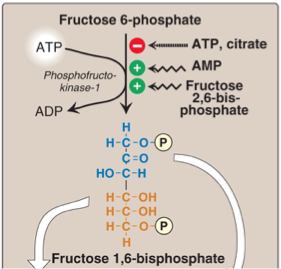
Regulated step
Regulatory enzyme
Irreversible reaction
AMP, and Fructose
Glycolysis: Enzyme PFK-1
PFK-1 is a regulated enzyme
PFK-1 is activated by ADP, AMP, cAMP, or fructose 2,6-bisphosphate (most potent activator)
PFK-1 is inhibited by ATP and citrate
When ATP levels are high, glycolysis is inhibited
when ATP levels are low, glycolysis is activated
WHY?
Levels of fructose 2,6-bisphosphate (produced elsewhere in the cell) are connected with insulin and glucagon
Indirect influence on glycolysis
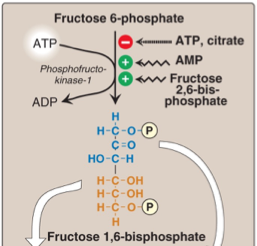
Glycolysis Step 4
Fructose 1,6-bisphosphate (from step 3)
Aldolase (enzyme)
Aldol groups are present on the substrate
Aldolase can create or break the aldol functional group
Aldol cleavage (reaction type)
Glyceraldehyde 3-phosphate (G3P) and dihydroxyacetone phosphate (DHAP)
Each has 3 carbons
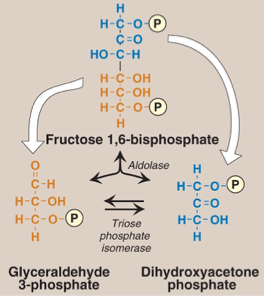
Glycolysis Step 5
Interconversion of G3P (aldehyde) and DHAP (ketone) occurs
Isomerization reaction
Both G3P and DHAP are monosaccharides
Triose
Triose phosphate isomerase (enzyme)
Two molecules of G3P are produced from one molecule of glucose
More DHAP gets converted to G3P
Further metabolism of G3P occurs and continues onward

Glycolysis Step 6
Glyceraldehyde-3-phosphate (G3P)
From step 5
Glyceraldehyde-3-phosphate dehydrogenase (enzyme)
1,3-bisphosphoglycerate (1,3-BPG)
Product
Phosphorylation reaction
Phosphate loaded
No ATP was invested!
NAD+ interconverts with NADH
Only if aerobic glycolysis
Redox reaction
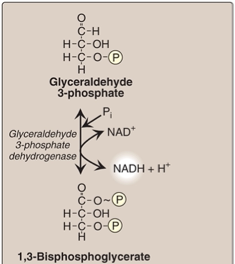
Glycolysis Step 7
1,3-Bisphosphoglycerate (from step 6)
Phosphoglycerate kinase (enzyme)
3-phosphoglycerate (3-PG)
Phosphorylation reaction
ADP to form ATP
1 ATP for every G3P formed
1,3-BPG has high energy because it has two phosphate groups
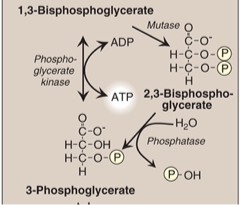
Note: Most 2,3-BPG is converted to 3-PG, but some escape; they cause hemoglobin to unload O2 to the muscle
Glycolysis Step 8
3-phosphoglycerate (3-PG)
From step 7
Phosphoglycerate mutase (enzyme)
2-phosphoglycerate (2-PG)
Product
Phosphoryl group shifts
Isomerization (reaction type)
Swaps the phosphate group*
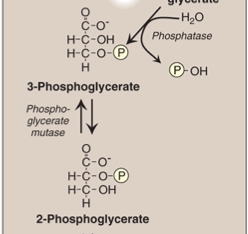
reversible reaction
Glycolysis Step 9
2-phosphoglycerate (from step 8)
Enolase (enzyme)
Phospho-enol pyruvate (PEP)
Not phosphenol
Product
H2O is lost in the reaction
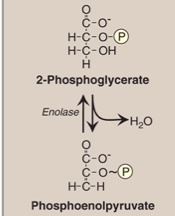
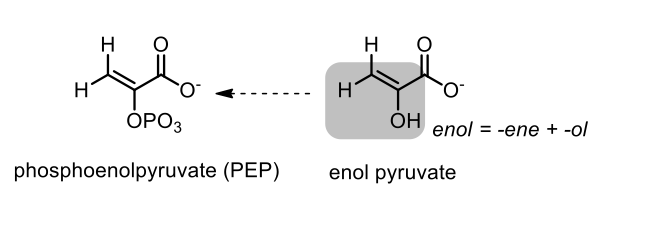
Glycolysis Step 10
PEP (starting material) has a high energy phosphate group
Pyruvate kinase (enzyme) catalyzes the transfer of PEP’s phosphate group to ADP
Irreversible reaction
Final product of glycolysis is pyruvate
Forms 1 molecule of ATP (for every molecule of G3P entering the energy producing phase)
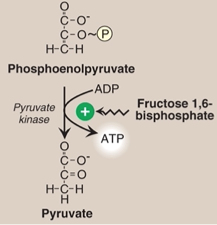
Glycolysis Overview
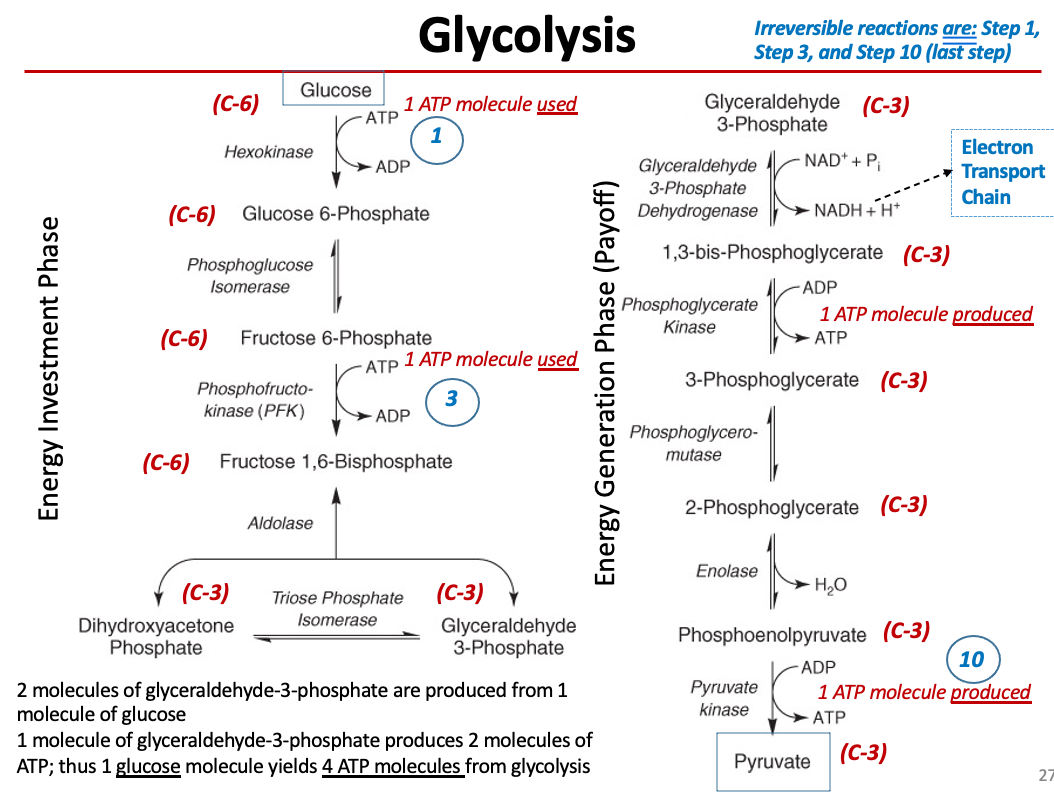
Energetics of Glycolysis
Energy Investment Phase
2 ATP molecules are used to initiate glycolysis
“Payoff” Phase
2 ATP molecules are produced from one molecule of 3-PG
4 ATP molecules are produced from one molecule of glucose
2 NADH molecules are created and enter the Electron Transport Chain
Assuming aerobic conditions
1 NADH = 3 ATP; 2 NADH = 6 ATP
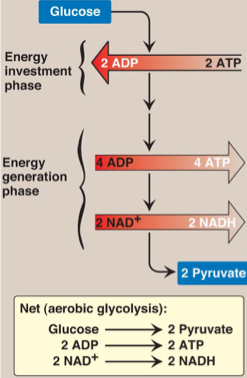
Hormonal Regulation of Glycolysis
In the well-fed state (carb-rich), insulin levels rise and glucagon levels drop
Reverse occurs in the starved state (carb-poor)
Regular consumption of carbs initiates an increase in insulin levels
Increases the conversion of glucose to pyruvate by activating
Hexokinase (Step 1)
Phosphofructokinase (Step 3)
Pyruvate kinase (Step 10)
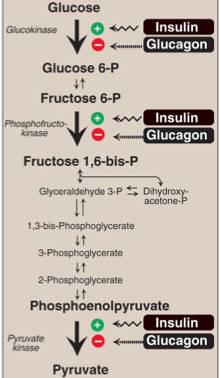
Lactate Fermentation
In anerobic respiration, pyruvate is reduced to lactate by lactate dehydrogenase (enzyme)
Ketone (Pyruvate) is reduced to an alcohol (lactate)
Pyruvate is converted to lactate in:
Poorly vascularized tissue or cells lacking mitochondria
Skeletal muscle during intense exercise; cramps occur as a result of lactate accumulation
The production of NAD+ assists in continued glycolysis
Step 6
Cori cycle (we’ll discuss this later)
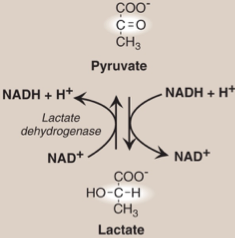
Alternate fates of Pyruvate
oxidative decarboxylation of pyruvate to acetyl CoA
Carboxylation of pyruvate to oxaloacetate (OAA)
Reduction of pyruvate to ethanol
Gluconeogenesis
Gluconeogenesis
Certain tissues need a continuous supply of glucose
Brain, erythrocytes, kidney, cornea, exercising muscle
Hepatic stores of glycogen are used (glycogenolysis)
Gluconeogenesis: Synthesis of glucose from non-carbohydrate precursors
Lactate, pyruvate, triacylglycerols (fatty acid source)
Occurs mostly in liver, and to a limited extent in the kidney
Does not occur in the muscle, nerve cells
Gluconeogenesis
Pyruvate is converted to Oxaloacetate (OAA)
OAA forms 2-phosphoenolpyruvate via malate
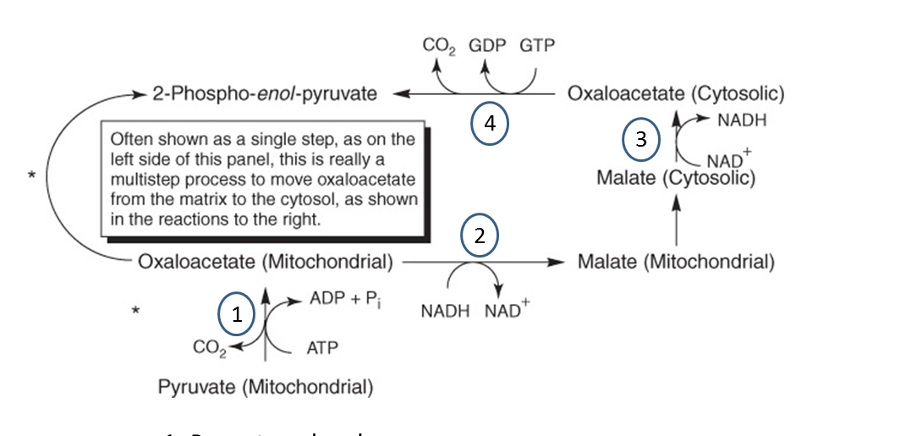
1. Pyruvate carboxylase
2. Malate dehydrogenase (reduction of OAA to malate)
3. Malate dehydrogenase (oxidation of malate to oxaloacetate)
4. PEP carboxykinase (decarboxylation, then phosphorylation)
Reaction occurs in mitochondria (involves Electron Transport Chain)
Pyruvate to Phosphoenol pyruvate via Oxaloacetate (OAA; step 1) and Malate (step 2)
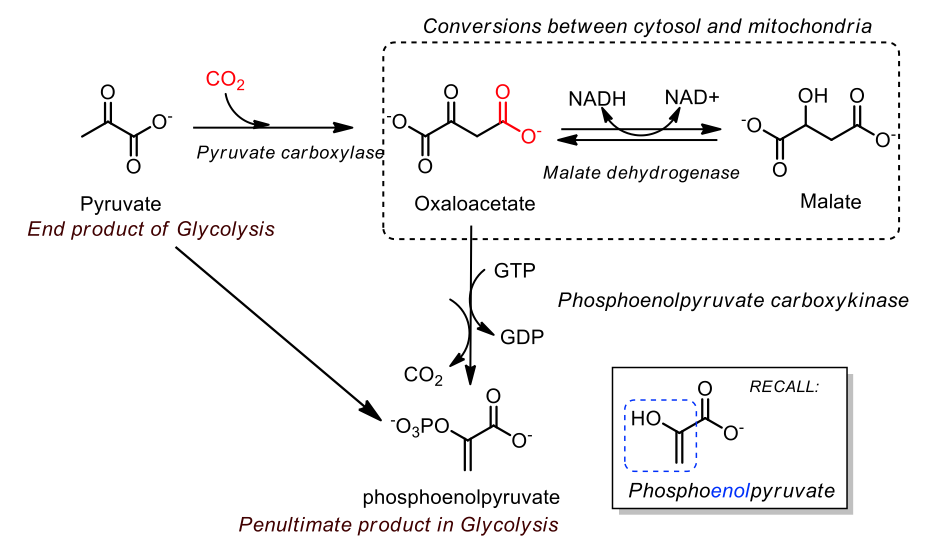
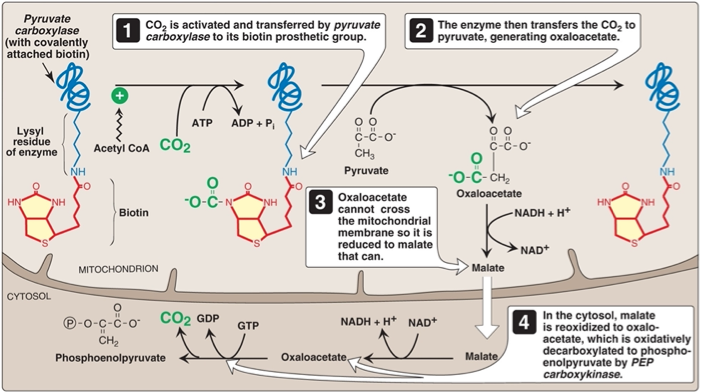
Gluconeogenesis: Steps 5 to 8
2-Phosphoenol pyruvate is converted to fructose 1,6-bisphosphate
Glyceraldehyde 3-phosphate: 3 carbon intermediate
Isomerizes to form DHAP
“Reverse reactions” of glycolysis
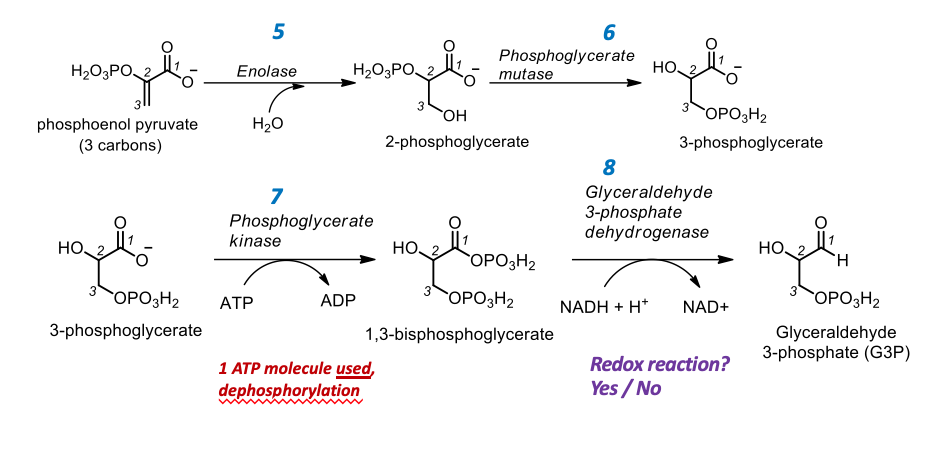
Gluconeogenesis: Steps 9 to 10
2-Phospho-enol pyruvate is converted to fructose 1,6-bisphosphate
G3P and DHAP condense to form fructose 1,6-bisphosphate
Fructose 1,6-bisphosphate is converted to glucose
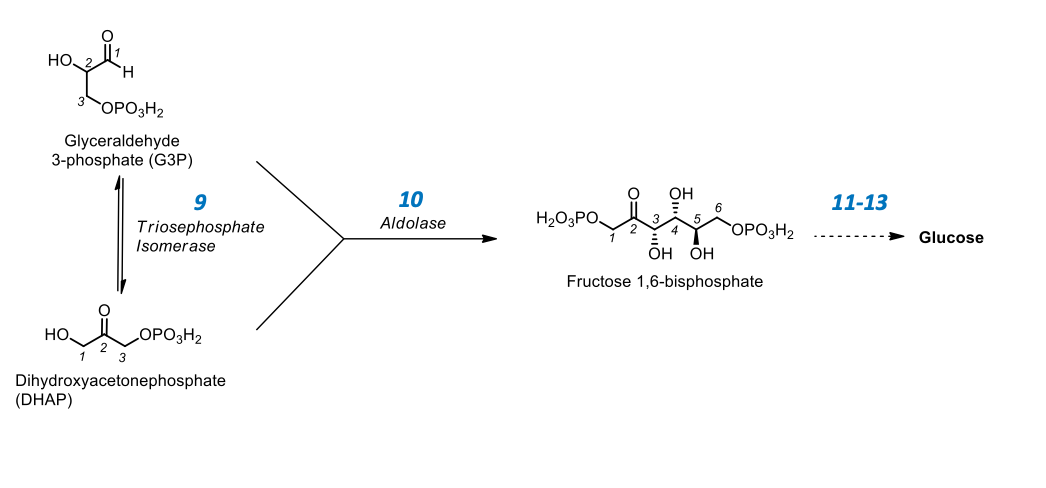
Gluconeogenesis: Steps 11 to 13
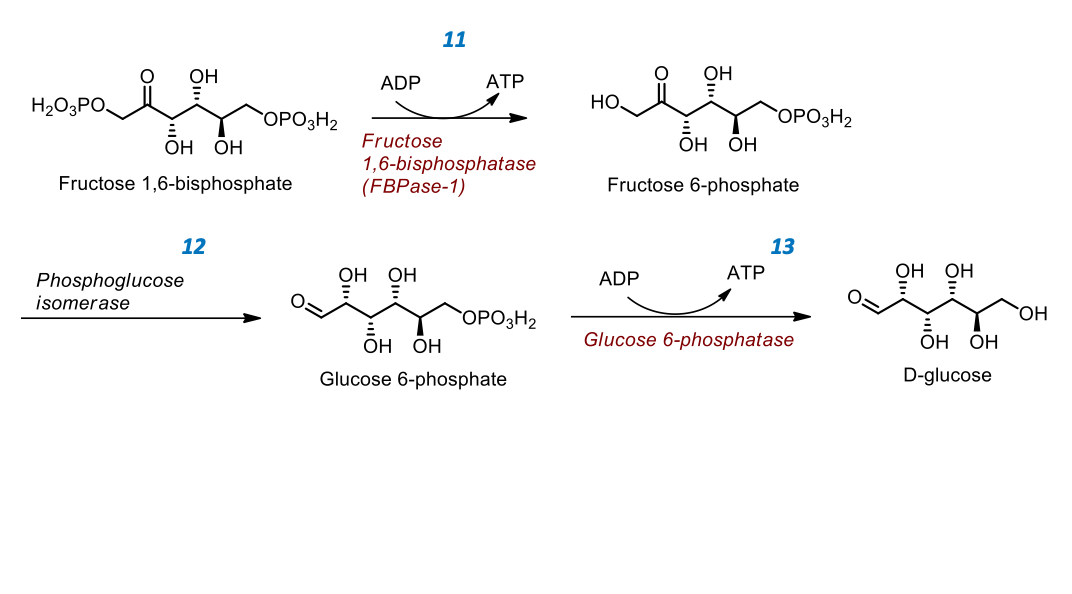
Step 11
Fructose-1,6-bisphosphate (from step 10)
Fructose-6-phosphate (product)
Fructose 1,6-bisphosphatase (enzyme)
Dephosphorylation (reaction type)
The analogous “reverse” reaction in glycolysis was catalyzed by PFK-1
This is bypassed in gluconeogenesis
Fructose-2,6-bisphosphate activates PFK-1 (glycolysis)
Fructose-2,6-bisphosphate inhibits fructose 1,6- bisphosphatase (gluconeogenesis)
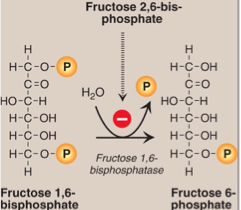
Steps 12 and 13
Step 12: Fructose 6-phosphate is isomerized to Glucose 6-phosphate
Phosphoglucose isomerase (enzyme)
Step 13: Glucose 6-phosphate is dephosphorylated to D-glucose
Glucose 6-phosphatase (enzyme)
Hexokinase (Step 1 of glycolysis) is not involved
Final step of gluconeogenesis
The release of free glucose from glucose 6-phosphate occurs only in the liver and kidney
Gluconeogenesis does not occur in the muscle
Muscle lacks glucose 6-phosphatase
Energetics of Gluconeogenesis
Gluconeogenesis is an anabolic process
4 ATP, 2 GTP, 2 NADH are used in gluconeogenesis
ATP and GTP are energetically equivalent
Energy resides in the phospho-anhydride bond
4 ATP, 2 NADH are produced in glycolysis
In the payoff phase
The difference in extra energy is needed to drive gluconeogenesis
Regulation of Glucogenesis
Pyruvate is the feedstock substrate for other cellular energy pathways
Pyruvate carboxylase (enzyme) helps convert pyruvate to oxaloacetate (OAA)*, which is a part of the TCA (Krebs) cycle
Pyruvate dehydrogenase (enzyme) catalyzes conversion of pyruvate to acetyl CoA*, the preparatory step in the TCA cycle
Therefore, pyruvate conversion is regulated
*Alternate fates of pyruvate
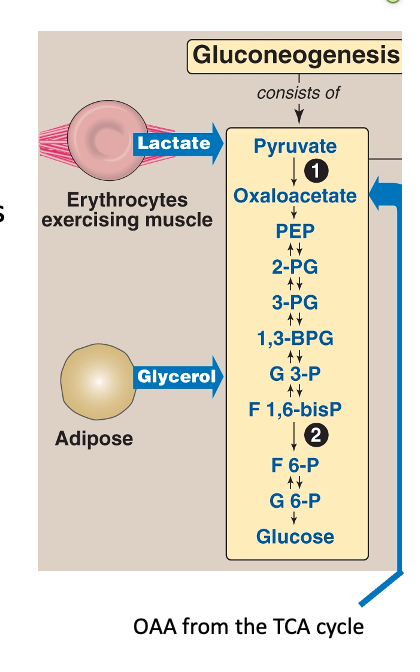
Fructose 1,6-bisphosphate is dephosphorylated to fructose 6-phosphate
Fructose 1,6-bisphosphatase (FBPase-1) (enzyme)
The reverse reaction in glycolysis is catalyzed by PFK-1
PFK-1: activated by AMP
FBPase-1: inhibited by AMP
Both enzymes are located in the cytosol
Both control opposing pathways
Reciprocal regulation
Cori Cycle (aka Lactic Acid Cycle)
Cori Cycle: The combination of glucose transport to actively working tissues, and the reverse transport of lactate from those tissues back to the liver
Useful to sustain glucose levels when glucose is unavailable
e.g. overnight fasting, starvation
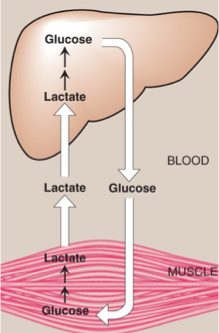
Steps of the Cori Cycle
Glucose in the muscle is converted to lactate (anerobic glycolysis)
Lactate diffuses to the blood and reaches the liver
Lactate is converted to glucose in the liver (gluconeogenesis)
Glucose re-enters muscle
Glycolysis starts

